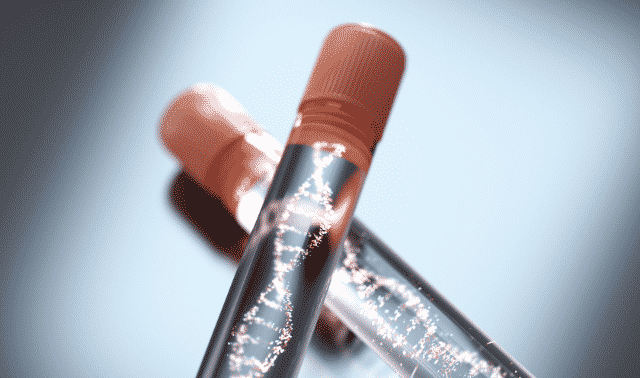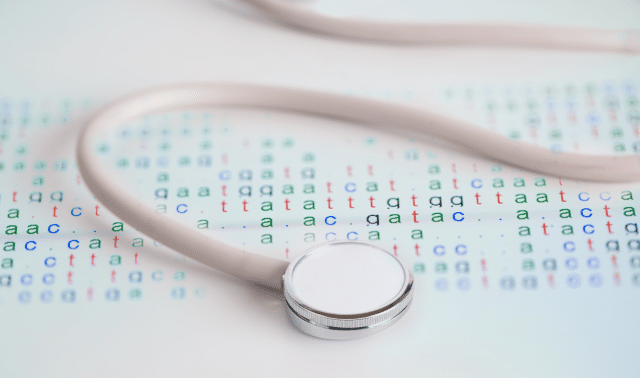Sign up for the Family Tree Newsletter Plus, you’ll receive our 10 Essential Genealogy Research Forms PDF as a special thank you!
Get Your Free Genealogy Forms
"*" indicates required fields

Suppose you ask a genetic genealogist the question, “Are the Milners kin to the Mileners who lived nigh to the Millers on Mile Mine road?” How would she answer? She’d order up a few DNA tests from the various testing companies, hoping that the right Milners and Mileners and Millers have already been tested to create the perfect settings for the perfect match.
Many who’ve jumped into genetic genealogy started with the autosomal DNA test. It’s possible they didn’t even know that fancy name for the spitting and swabbing, but those who’ve tested at AncestryDNA, taken Family Tree DNA’s Family Finder test or spit for 23andMe or MyHeritage have completed an autosomal DNA test.
Autosomal DNA vs. mtDNA vs. Y-DNA
The autosomal DNA test is only one of three kinds of genetic genealogy tests. It can track both your mom’s and your dad’s sides of the family—anyone who contributed DNA to you. The other two available tests track just one line of inheritance. The Y chromosome DNA (Y-DNA) test follows the male line (your father’s father’s father and so on); only men can take it. The mitochondrial DNA (mtDNA) test traces just your direct maternal line (your mother’s mother’s mother), and anyone can take it.
But let’s put this in easier-to-understand terms: If the Y-DNA test is like looking at just one blue crayon, and the mtDNA test is like looking at one green crayon, the autosomal DNA test is like dealing with a box of 96 crayons—including the ones with color names like Wisteria, Cerise and Fuzzy Wuzzy, which don’t give a hint as to the crayon’s actual color. Likewise, your autosomal DNA matches can’t immediately divulge which ancestral line they share with you. How’s a test like that supposed to help you trace your family tree? We’ll show you two approaches to analyzing your autosomal DNA matches and describe how DNA testing helped one man piece together a clearer picture of his family tree.
Which autosomal DNA testing company is best?
People are always asking me which DNA test they should take and which company they should go with. When it comes to the three autosomal DNA testing companies, choosing just one can be as difficult as choosing your favorite child (though honestly, some days my kids make this easy for me, at least to pick the one I don’t like).
Ethnicity results and match list
All three companies provide two different kinds of results from your cheek swab or saliva sample: your admixture (or ethnicity results) and your match list. Admixture results are usually displayed as visually pleasing charts and maps. While this can confirm basic origins, such as British or Middle Eastern roots, and point out American Indian or African American heritage you might’ve been wondering about, your match list is much more likely to lead to research breakthroughs. See the July/August 2015 Family Tree Magazine for help understanding your admixture map. But let’s turn our focus today to making the most of your match list.
Do you remember those shape-sorter toys? The ones with different-shaped holes, and you had to find the right-shaped block to go inside? DNA matching should be a similarly simple principle: Either it matches or it doesn’t. Unfortunately, it isn’t nearly so straightforward. Get out your box of crayons again. You might expect that if you have blue DNA, you can find other blues that match, and all of you share a common blue ancestor (Cookie Monster?). People with green DNA find the other greens, thereby connecting to their common ancestor (Kermit the Frog?).
The problem with DNA is that it comes not only in blue and green, but also in aquamarine. Does that match the blue or the green? (Are you imagining a Cookie Monster/Kermit hybrid ancestor?) These are the kinds of questions geneticists face as they try to decide whether two people share a common ancestor based solely on their DNA results. Different testing companies treat this problem differently, and so far, there isn’t one right answer.
But autosomal DNA match lists do have common elements across companies: When your results are in, you log into the company’s website to view matches’ names, relationship ranges (such as “third to fifth cousins”), ways to search and sort the list, and family tree information. As more people are tested over time, your list is updated with new matches. Note that the relationship range assigned to each match is just a suggestion. It’s based on the estimated amount of DNA that’s identical in you and your match. But because we inherit varying amounts of DNA from each ancestor, it’s possible the actual relationship between two matches is different from the one the testing company predicts, or that the identical DNA is coincidental and doesn’t indicate a relationship. It’s like saying, “Hey, you have a blue block with some angular sides? Try it in one of these three holes over here and see if it fits. Maybe it will, maybe it won’t.”
Estimating relationships
Also keep in mind that even though the testing company website might say you’re third cousins, you could instead have a genetically equivalent relationship, such as second cousins twice removed. Or you might have multiple shared ancestors who lived further back in time, giving you enough DNA in common to look like third cousins. Keep in mind that many in the genetic genealogy community have found that Family Tree DNA overestimates relationships, Ancestry DNA underestimates, and 23andMe is somewhere in the middle. (The jury’s still out about MyHeritage DNA.) What were we just saying about the complexity of puzzling out autosomal DNA relationships?
Tracing ancestors using autosomal DNA
But in the end, you’re coming to the match list to find ancestors, not cousins. Your best matches are those that lead you to ancestors. The amount of genealogical information each match provides varies depending on the person and the genealogy tools of the testing company. Currently, the genealogy tools at 23andMe and Family Tree DNA could use some improvement.
AncestryDNA, which makes use of customers’ family trees to place test-takers who share ancestors in “circles,” leads the pack in genealogical tools. But this site is also far from perfect. Test-takers can share genealogical information only by linking a public tree to their DNA test profile. Many don’t feel comfortable sharing their entire pedigrees and end up sharing nothing. This not only makes it difficult for matches to make connections, but it also restricts the test-taker’s access to DNA Circles and the New Ancestor Discoveries tool (see below).
You’ll get the most out of your DNA test by including as much genealogical information as possible in your DNA profile. If you can create only a list of surnames and locations, do it. If you can link a family tree to your DNA profile, please do. If you’re uncomfortable sharing your whole family tree, set up a separate skeleton tree with just names and birth, marriage, and death dates and places. Then be sure to log in every so often and respond to any messages from potential cousins.
If you’ve tested with AncestryDNA, your best matches may be gathered into DNA Circles. A DNA Circle is a group of matches based on a common ancestor named in test-takers’ family trees. Each circle member matches at least one other person in the circle (learn more). This makes it easy to see how you’re related to other matches in the circle. You also might see New Ancestor Discoveries (suggested ancestors based on whom you match) for folks not already named in your tree; see the details.
Otherwise, your match list may contain thousands of genetic cousins, with the closest matches first. Scan their posted genealogical information for surnames and locations you recognize. If you find your relatives named on their trees, send a message and exchange genealogical information.
Tackling your DNA match list
What’s left once you’ve figured out the obvious matches? An abundance of UFOs—Unidentified Familial Offspring—whose trees don’t name the same ancestors as your tree. I’ll let you in on a secret: It’s hard work to turn cousins into ancestors. Identifying UFOs takes persistent searching and a lot of traditional genealogy, with a smidgen of genetics thrown in.
Let’s tackle two ways you can approach your DNA match list to get started turning those cousins into ancestors: The Ancestor Approach and the Match Approach. For either one, keep a spreadsheet so you can easily see the ancestral surnames and places you share, helping you narrow down a potential connection. Your spreadsheet could name each match, with columns for surnames, places and notes.
The Ancestor Approach
This four-step method is the way to go when you want to verify known ancestors in your pedigree and try to extend your line beyond that ancestor.
- Choose an ancestor in your pedigree chart who’s fewer than four generations back.
- Assemble a descendancy chart for this ancestor. It’ll name that ancestor and all his or her descendants—that is, anyone who inherited the person’s DNA. Include the life dates and places associated with each person on the chart. You may be able to easily generate a descendancy chart from your family tree software.
- Perform searches for all those surnames and locations in your autosomal DNA match list. All the genetic genealogy testing companies let you search your matches’ genealogical information by surname or location. In Ancestry DNA, for example, you’d click in the search box at the top right of your match list and enter a name or place. Results are the surnames of the match’s ancestors or the places those ancestors lived. You’re looking for overlap that could indicate the match shares ancestry with you via the person you selected in step 1.
- Verify any connection you find with genetic information. For example, if you identify a likely common ancestor in the sixth generation back, but your testing company predicts that you and your match are second to fourth cousins, you may need to re-evaluate this potential connection. Evaluate connected lines for clues to point your genealogical research in a particular direction so you can look for evidence of the relationship in historical records.
The Match Approach
With this method, you start with your matches and look for names and places in common with your clan.
- Choose the highest-ranked match on your list for whom you don’t know your relationship.
- Note the predicted relationship range. At 23andMe, clicking on the name of your match will bring up a more specific relationship estimate, such as third or fourth cousin, rather than a range such as “second to fourth cousins.” At Family Tree DNA, you can use the total number of shared centimorgans (a unit of measure for DNA; the more you share, the closer the relationship) and a table like this one to help you estimate how you’re related. If both you and a potential match have registered with the GEDMatch website and exchanged GEDMatch kit numbers, you can perform a one-to-one comparison on the site and see a centimorgan count there.
- Use this predicted relationship range to isolate which great- or great-great- or great-great-great- (I could keep adding greats) grandparents are your “target audience” when making a connection.
- Evaluate the surnames and locations of your ancestors in that predicted range against those of your matches in the same range and choose the most likely couple. Then look for additional matches by employing the Ancestor Approach for this couple.
A version of this article appeared in the October/November 2015 issue of Family Tree Magazine.
Related Reads
ADVERTISEMENT







